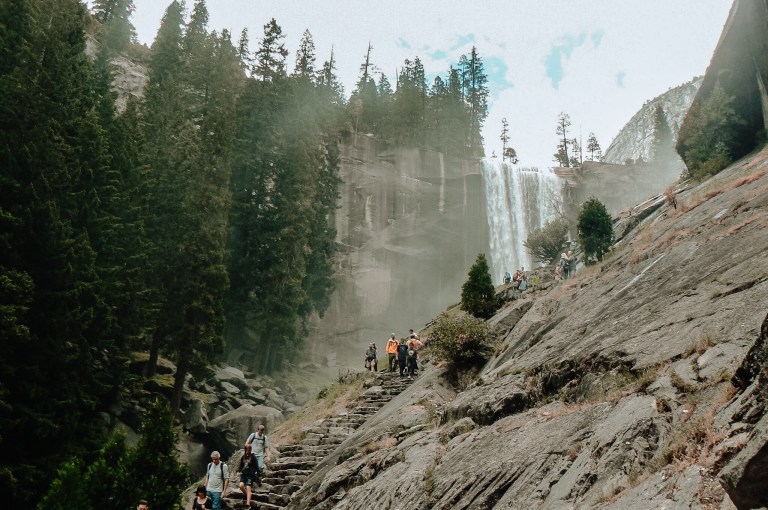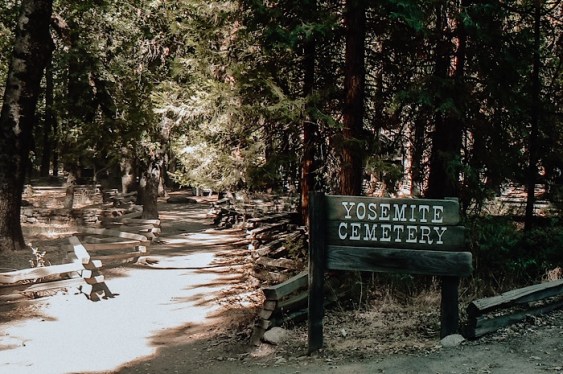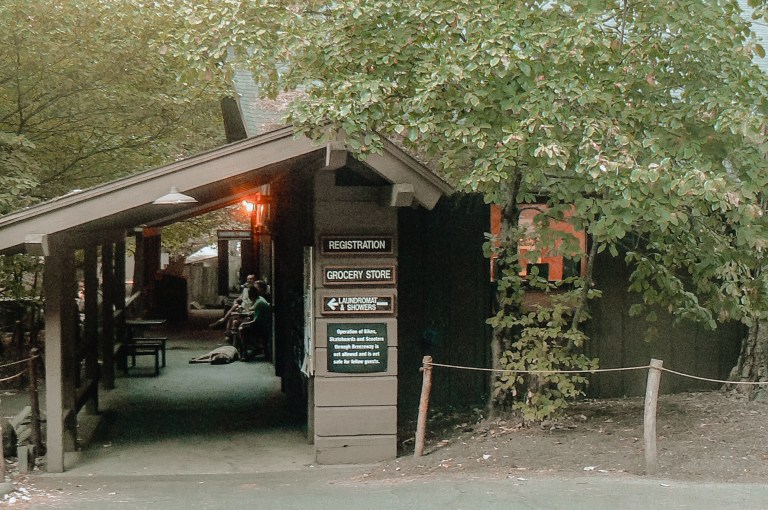Every trail, every waterfall, and every sunrise in Yosemite has the potential to create lifelong inspiration and memories. Below is a list of classic things to do in the park that will ensure you have an amazing vacation. As with any travel destination, some of the best moments happen in between the planned activities, so be sure to allow yourself some downtime to relax and read a book at your camp or have a long picnic with an amazing view.
Looking for Yosemite Itineraries? Be sure to check out my hand-craftded Yosemite Valley Itineraries.
This article contains affiliate links. If you use these links to buy something I may earn a commission. For more info, please see my affiliate disclaimer.
See Yosemite Falls (The First Thing to Do)
Yosemite Falls is one of the tallest waterfalls in North America, towering at 2,425 feet. The hike to the falls is beautiful all year round, but to see the waterfalls at their fullest, be sure to visit Yosemite in the spring. I always recommend this as the first thing to do once arriving into Yosemite because it’s the life of the valley and it’s an amazing place to start your trip. Yosemite Falls can be seen from all over park, providing some amazing opportunities for nature and travel photography lovers. To get up close and personal with the falls, there are a couple hikes to choose from:
Hike the Lower Yosemite Falls Trail
There is a very easy hike that takes you right to the base of lower Yosemite Falls. A 1.2 mile loop trail, this easy-paced hike provides lots of shade, involves a small amount of incline, and takes you to the bridge at the base of Lower Yosemite Falls. You can stand on the bridge while the water rushes under you and feel the mist from the falls against your face. This is a relaxing hike and is perfect any time of day.
Hike the Upper Yosemite Falls Trail
For the more adventurous, there is a an intense all-day hike that will take you to the very top of the falls. It’s a 7.6 mile trail that is out and back. It’s a strenuous hike, but the view from the top of the falls, overlooking the valley below while the powerful water cascades and crashes onto the rocks below, provides the ultimate payoff.

Summit Glacier Point
Glacier Point is a breathtaking viewpoint to see the valley below. Standing at an elevation of 7,214 feet, this overlook is one of the most iconic things to do in Yosemite. This spot is popular with nature and travel photographers looking to catch unique views of half dome. To see amazing light and shadows on the valley, plan to be at this spot for sunrise or sunset. There is a restroom at the top, as well as a gift shop with snacks and Yosemite souvenirs. Visitors have a couple ways of experiencing Glacier Point:
Hike to Glacier Point via the Four Mile Trail
The hike up to Glacier Point, called the Four Mile Trail, is actually closer to about 4.5 miles each way, making the roundtrip hike about 9 miles total. It’s a strenuous hike with extreme elevation gain. The trail itself provides amazing views of the valley on your way up to Glacier Point. One tip is to take the park shuttle or get dropped off at the top and hike down. This option allows you to get the experience in a less strenuous way. The hike down does have a pretty steep decline with lots of gravel at times, so I would recommend it to hikers who are ok with a moderate level of difficulty.
Take a Shuttle up to Glacier Point
For park visitors who want to experience the awe of Glacier Point without the hike, it’s recommended to take the Glacier Point Shuttle. The total tour is about 4 hours roundtrip, with time included for sightseeing at the top. The trip is done in a comfortable, air-conditioned shuttle. There are usually 2 shuttles running per day, so be sure to plan ahead by checking the departure times and availability. I’ve taken the Glacier Point shuttle up once myself, and I found that I really enjoyed the narration and stories from the driver, who was happy to share his expertise on Yosemite history.

See Half Dome
One of the most iconic landmarks in Yosemite, this giant mountain can be seen from multiple areas of the park. Great views and photo opportunities of half dome can easily be found from Cook’s Meadow or the Yosemite Falls shuttle stop area. While climbers can no longer scale the face of the rock, there is a strenuous 16 mile out and back hike that will take you to the very top, up the back of the mountain. The last part of the hike involves holding onto steel cables while climbing up a steep vertical incline before getting to stand at the top and admire the views of the valley below. If planning to embark on this endeavor, be sure to plan ahead and apply for a Half Dome Hiking Permit.

Stroll Around Mirror Lake (a relaxing thing to do in Yosemite)
Strolling around Mirror Lake is one of the more relaxing things to do in Yosemite Valley. There is plenty of shade, and its location provides some unique views of half dome. Visitors can wander around the lake or follow the Valley Loop Trail. My favorite thing to do is bring a picnic lunch to enjoy at a good spot near the lake with a view. I always seem to spot deer and unique birds in this area. For hikers, this can be nice easy activity the day after an intense hike.

Hike Vernal Falls, aka The Mist Trail (my favorite thing to do in Yosemite)
The hike up to Vernal Falls is one of my favorites. It’s a moderate pace and is about 4 miles out and back. I recommend starting this hike in the morning to avoid heat and crowds. The trail involves lots of stairs made of rock, which can be slippery when wet. What I love about this trail is that there are views the whole way up. You start out with views of the rushing Merced river, and then you’re faced with close up views of the falls as you climb to the top.
The Vernal Falls hike is also called the Mist Trail because the latter half of the trail is close to the waterfalls that hikers get covered with mist. If visiting in spring or early summer when the falls are large and booming, prepare to get wet. Proper hiking shoes and rain ponchos are recommended. After enjoying the view from the top of Vernal Falls, hikers have the option to turn around and head back down or keep hiking up to Nevada Falls.

Raft Along the Merced River (the best summer thing to do in Yosemite)
Rafting along the Merced River is the perfect way to spend a summer afternoon in Yosemite Valley. If you can’t bring your own raft and oars, they are available for renting inside the park. Ask a ranger or front desk clerk for the best starting and ending river points near you. Tip: pack a lunch and find a lovely spot to stop on the river and enjoy a picnic. There are some shallow rocky stops along the river to pull off, or you can even bring some rope to tether your raft where needed.

Visit the Ansel Adams Art Gallery
Visiting the Ansel Adams Art Gallery is the perfect thing to do for photographers or those who admire the iconic works of Ansel Adams. Located in Yosemite Village, stopping at this art gallery is a convenient and inspiring thing to do on your trip. Browse the black and white framed prints of the valley to see Yosemite threw Ansel Adams’ lens. There are opportunities to purchase his works, as well as see art from other photographers and artists all inspired by the same beauty. Interested in travel photography? Check out what’s in my camera bag. Fan of Instagram? Check out my Top Instagram Spots in Yosemite Valley.

Visit the Museum and Cemetery (a historical thing to do in Yosemite)
The Yosemite museum is full of amazing Yosemite and Native American history. You will see displays of cultural history, beautiful artifacts, and old photos. This is a great way to spend a relaxing afternoon and gain a greater understanding of the history of valley. Nearby is an old cemetery with graves dating back to the 1800’s.

Take a Guided Bus Tour (the easiest thing to do in Yosemite)
Yosemite guided bus tours are a great way to see the valley without hiking. The are options for everyone, including the roundtrip Glacier Point tour, a 2 hour Valley Floor Tour, or, one of my favorites, the 2 hour Moonlight Valley Floor Tour. The Moonlight Tours start at 9:30pm and run in the summer time. For some Yosemite magic, book your tour during a full moon. As always, be sure to check the available times and operating schedule in advance to guarantee yourself a spot on one of these tours.

Go for a Bike Ride
Bring your bike along for a fun activity and also an efficient way to get around the park. Bikes are available for renting from June to November at Yosemite Lodge, Curry Village, or the Village Store. Be sure to bring a bike lock and bike lights for riding at night! Rates for rentals vary depending on whether you want a half day or full day rental. There are many bike routes in the valley and plenty of areas to park and lock up your bike at trailheads and popular areas.

Sit by the Campfire (the best thing to do in the evening)
One of my favorite evening things to do in Yosemite Valley is to sit by the campfire. If you’re camping in the park or staying at Housekeeping Camp, get that fire going as soon as it’s dark, and enjoy some beers and s’mores. I like to bring my own food and supplies to be able to cook near the fire as well. Firewood is available for purchase inside the park. If staying at housekeeping, be sure to check out my Housekeeping Packing List.

Yosemite Visitor Center
Visiting the Yosemite Valley Visitor Center is a smart thing to do at the start of your trip. Open all year, the visitor center is centrally located in Yosemite Village. It is the perfect place to go for information about various, hikes, tours, and activities. They sell books and maps, as well, covering a variety of Yosemite topics like history, photography, as well kids books.

Pin it for Later: Things to Do in Yosemite Valley

Planning a Visit? Explore More Yosemite.
- Start your packing with my Yosemite Packing List
- Follow my 2 day itinerary or 4 day itinerary for tips on planning your Yosemite vacation.
- Get more planning tips, including when to visit and where to stay, with my Ultimate Yosemite Valley Travel Guide
- Check out some of my suggested Yosemite Hiking and Camping Tours.






















































